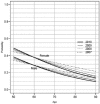Predictors of place of death in South West Scotland 2000-2010: Retrospective cohort study
- PMID: 26857358
- PMCID: PMC4994701
- DOI: 10.1177/0269216315627122
Predictors of place of death in South West Scotland 2000-2010: Retrospective cohort study
Abstract
Background: Surveys suggest most people would prefer to die in their own home.
Aim: To examine predictors of place of death over an 11-year period between 2000 and 2010 in Dumfries and Galloway, south west Scotland.
Design: Retrospective cohort study.
Setting/participants: 19,697 Dumfries and Galloway residents who died in the region or elsewhere in Scotland. We explored the relation between age, gender, cause of death (cancer, respiratory, ischaemic heart disease, stroke and dementia) and place of death (acute hospital, cottage hospital, residential care and home) using regression models to show differences and trends. The main acute hospital in the region had a specialist palliative care unit.
Results: Fewer people died in their own homes (23.2% vs 29.6%) in 2010 than in 2000. Between 2007 and 2010, men were more likely to die at home than women (p < 0.001), while both sexes were less likely to die at home as they became older (p < 0.001) and in successive calendar years (p < 0.003). Older people with dementia as the cause of death were particularly unlikely to die in an acute hospital and very likely to die in a residential home (p < 0.001). Between 2007 and 2010, an increasing proportion of acute hospital deaths occurred in the specialist palliative care unit (6% vs 11% of all deaths in the study).
Conclusion: The proportion of people dying at home fell during our survey. Place of death was strongly associated with age, calendar year and cause of death. A mismatch remains between stated preference for place of death and where death occurs.
Keywords: Place of death; acute hospital; advance care planning; cause of death; cottage hospital; death; dementia; home; hospice; hospice care; palliative care; patient preference; residential care.
© The Author(s) 2016.
Conflict of interest statement
The author(s) declared no potential conflicts of interest with respect to the research, authorship and/or publication of this article.
Figures



Similar articles
-
Trends in place of death: The role of demographic and epidemiological shifts in end-of-life care policy.Palliat Med. 2017 Dec;31(10):964-974. doi: 10.1177/0269216317691259. Epub 2017 Feb 13. Palliat Med. 2017. PMID: 28190375
-
Policy for home or hospice as the preferred place of death from cancer: Scottish Health and Ethnicity Linkage Study population cohort shows challenges across all ethnic groups in Scotland.BMJ Support Palliat Care. 2015 Dec;5(4):443-51. doi: 10.1136/bmjspcare-2013-000485. Epub 2013 Nov 19. BMJ Support Palliat Care. 2015. PMID: 24644191
-
Where do cancer patients die? Ten-year trends in the place of death of cancer patients in England.Palliat Med. 1998 Sep;12(5):353-63. doi: 10.1191/026921698672530176. Palliat Med. 1998. PMID: 9924598
-
Place of Death: Trends Over the Course of a Decade: A Population-Based Study of Death Certificates From the Years 2001 and 2011.Dtsch Arztebl Int. 2015 Jul 20;112(29-30):496-504. doi: 10.3238/arztebl.2015.0496. Dtsch Arztebl Int. 2015. PMID: 26249252 Free PMC article. Review.
-
[Where do people die?: On the question of dying in institutions].Z Gerontol Geriatr. 2011 Oct;44(5):336-9. doi: 10.1007/s00391-011-0181-6. Z Gerontol Geriatr. 2011. PMID: 21512854 Review. German.
Cited by
-
The Association between Quality Improvement Initiatives in Dementia Care and Supportive Psychosocial Work Environments in Nursing Homes.Healthcare (Basel). 2018 May 8;6(2):44. doi: 10.3390/healthcare6020044. Healthcare (Basel). 2018. PMID: 29738507 Free PMC article.
-
Predictors of death at home among cancer patients in Israel: a population-based study.Int J Equity Health. 2021 Apr 10;20(1):99. doi: 10.1186/s12939-021-01437-y. Int J Equity Health. 2021. PMID: 33838680 Free PMC article.
-
Family Members' Experience of Discussions on End-of-Life Care in Nursing Homes in Japan: A Qualitative Descriptive Study of Family Members' Narratives.J Hosp Palliat Nurs. 2020 Oct;22(5):401-406. doi: 10.1097/NJH.0000000000000677. J Hosp Palliat Nurs. 2020. PMID: 32769693 Free PMC article.
-
Comparing unplanned and potentially planned home deaths: a population-based cross-sectional study.BMC Palliat Care. 2018 May 2;17(1):69. doi: 10.1186/s12904-018-0323-3. BMC Palliat Care. 2018. PMID: 29720154 Free PMC article.
-
Individual, clinical and system factors associated with the place of death: A linked national database study.PLoS One. 2019 Apr 18;14(4):e0215566. doi: 10.1371/journal.pone.0215566. eCollection 2019. PLoS One. 2019. PMID: 30998764 Free PMC article.
References
-
- Dixon J, King D, Matosevic T, et al. Equity in the provision of palliative care in the UK: review of evidence. Personal Social Services Research Unit, London School of Economics, April 2015, www.pssru.ac.uk/publication-details.php?id=4962 (accessed 12 September 2015).
-
- Gomes B, Higginson I, Calanzani N, et al. ; on behalf of PRISMA. Preferences for place of death if faced with advanced cancer: a population survey in England, Flanders, Germany, Italy, the Netherlands, Portugal and Spain. Ann Oncol 2012; 23: 2006–2015. - PubMed
-
- National Records Scotland Annual Vital Events Statistics. http://www.nrscotland.gov.uk/statistics-and-data/statistics/statistics-b...
-
- Gomes B, Calanzani N, Higginson IJ. Reversal of the British trends in place of death: time series analysis 2004–2010. Palliat Med 2011; 26: 102–107. - PubMed
-
- Broad JB, Gott M, Kim H, et al. Where do people die? An international comparison of the percentage of deaths occurring in hospital and residential aged care settings in 45 population, using published and available statistics. Int J Public Health 2013; 58: 257–267. - PubMed
MeSH terms
LinkOut - more resources
Full Text Sources
Other Literature Sources
Medical

